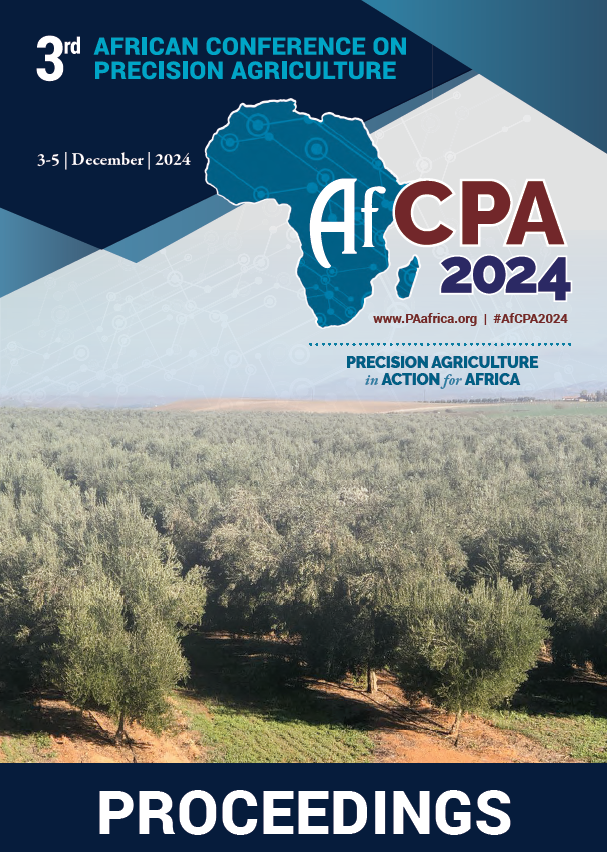Download the Conference Proceedings
Proceedings
Topics
| Filter results8 paper(s) found. |
|---|
1. Comparative Assessment of Landuse Landcover Changes on Water Quality of River Kaduna from 2012-2020 at Wuya, Niger State, NigeriaThe study investigates the effects of land use land cover changes on water quality of River Kaduna from 2012-2020 at Wuya, Niger state, Nigeria using Landsat 7 imagery. Five classes of LULC types where selected and used as basis for classification. Also five (5) sampling stations selected on the water body for water quality analysis which were collected once monthly for a period of six months from February 2020 to July 2020. The results of LULC classification depicts an increase in water body... I. Saratu usman, F. Yusufu |
2. Factors Influencing Farmers’ Decisions on Timing and Application Rates of Irrigation Water in Semi-Arid Regions: A Case-Study of Mwala, Machakos County, KenyaThis study investigates the factors influencing farmers’ decisions on water application in arid and semi-arid regions, where water shortages are prevalent due to low and unreliable rainfall. The research involved interviewing 41 farmers registered under the Equity Group Foundation extension scheme, focusing on their irrigation scheduling techniques, timing, application rates, and other factors such as plant and soil conditions. The study also involved laboratory analysis of soil samples... D. Mongína, C.K. Gachene, G. Kironchi |
3. Evaluating the Impact of Seasonal Weather Variability on Soil Moisture Conservation Under Mulching Systems for Date Palm Production in OasesSoil moisture is an essential parameter that governs crop production and soil health. Therefore, the critical role of soil moisture cannot be overstated in sustaining agriculture, especially in arid and semi-arid regions. Date palm production not only plays a vital role in economic and nutritional purposes in many arid areas but also plays important roles in creating favorable microclimates for agriculture and protecting lands from desertification. This study proposes an innovative appr... U. Safi, O. Abdallah , A. Sabri |
4. Rainwater Harvesting and Nutrient Intensification in Maize-Legume Farming Systems in Semi-Arid ZimbabweAgricultural productivity in Zimbabwe is declining mainly due to climate change and inherently poor soil fertility. The situation is worsened by the high cost of fertilizers beyond the reach of many smallholder farmers. In response to these challenges, most smallholder farmers are implementing either rainwater harvesting (RWH) or integrated soil fertility management (ISFM). This study sought to investigate the role of integrating the tied-contour RWH (TC-RWH) technique and ISFM on soil moistu... E. Mutsamba-magwaza, D. Nyamayevu, G. Nyamadzawo, R. Mandumbu, I. Nyagumbo |
5. Upland Rice Yield Response to Soil Moisture Variability with Depth Across Ferralsols and Gleysols in Western UgandaSoil moisture is a vital factor in boosting rice productivity by influencing the growth of healthy plants. In mid-western districts like Kikuube where rainfall is unpredictable, maintaining optimal soil moisture differs between a bountiful harvest and crop failure. Effective soil moisture management leads to improved water use efficiency, allowing crops to withstand periods of drought. This study assessed upland yield response to soil moisture variations with soil depth in Ferralsols and Gley... T. Matila, P. Tamale |
6. Real-Time Moisture Control in Irrigation Systems for Water Use Efficiency and Climate Change Resilience. A ReviewDue to the increasing water scarcity and uncertainties of climate change, improving crop water use efficiency and productivity, at the same time minimizing detrimental effects on the environment to meet the world's rising food demand. Thus, is necessary to adopt innovative irrigation strategies, such as drip irrigation. Smart irrigation has a potential of improving water use efficiency in precision agriculture. Conventionally, irrigation systems rely on heuristic methods in order to sched... D. Kindikiza |
7. Design and Development of a LoRa Communication System for Scalable Smart Irrigation SystemsSmart irrigation is a promising tool to optimize irrigation water use but is still faced with challenges related to usability and applicability attributed to several constraints such as high initial costs, complex user interface, poor connectivity, limited farm coverage, etc. This study aimed to solve some of these issues through the development and testing of a LoRa communication system using a Raspberry Pi 4, LoRa HAT concentrator, and Strega smart valve at the Makerere University Agricultu... J. Wanyama , J. Ikabat, I. Kabenge, P. Hess, P. Nakawuka, E. Bwambale , J. Muyonga, S. Felicioni, A. Bühlmann, T. Anken |
8. Investigating the Interaction Between Soil Moisture and Clay Content for Enhanced Soil Moisture Prediction: A Lab-Based Approach with Implications for African Agriculture... Y. Atyosi |
